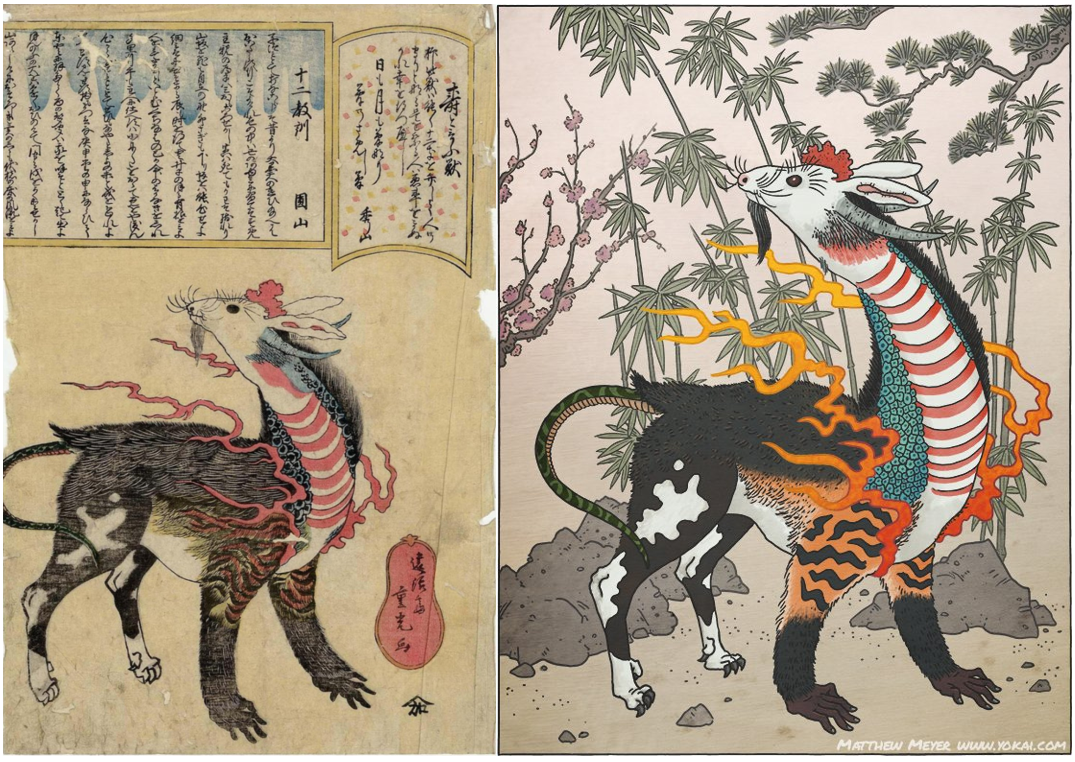The Whippet #127: Mannequin Avalanche
On this page

Hello Art of Noticing people!
Every time I get a bunch of new subscribers (or one subscriber, but it’s someone really cool), I get all anxious, like “oh man, I better make this next issue extra good, and not put in any self-indulgent bullshit.” The problem with that is, I am already always trying to make the newsletter good, and don’t have any ability to somehow supercharge that through sheer force of will. And due to ‘bundling’ [the fact that this newsletter has a bunch of different sections on different topics], I don’t even know if cutting the self-indulgent bullshit* would help. Are people merely tolerating it, or is it the part they specifically like?
Please know that this is basically what I imagine you all look like:

* If you’re wondering, in this issue it’s the section on Bes. Last issue, it was the neural network-generated advice column + cover image.
Hello regular people!
Rob Walker of the excellent newsletter (and book), The Art of Noticing, asked if I might have some advice that “might help or just encourage people to get a little better at noticing, looking, paying attention, staying curious, engaging with the world.”
And I do! Which you can and should read here (not paywalled).
The Art of Noticing is very much in the same spirit as The Whippet. The content is quite different, but it’s about, well, the things listed above — how to stay curious, stay engaged with the world. It was a godsend during lockdown, when our worlds all got so much smaller. We had to find a way to get interested in the small, nearby things, because we had to keep each other safe by avoiding the grand and far away things. We had to find ways of making the everyday novel, because we couldn’t actually go somewhere new and I personally go mad very quickly from lack of novelty. The newsletter is super practical — it doesn’t just say that you should be more curious, etc., it has little exercises, games, questions, habits etc. to try. And you should subscribe!

Kotobuki, a chimera made up of parts of all 12 zodiac animals

‘Kotobuki’ means ‘congratulations’ or ‘long life’. The name kotobuki is a celebratory and congratulatory word, which makes this creature instantly identifiable as a powerful and auspicious creature.
It has the:
- head of a rat
- ears of a hare
- horns of an ox
- comb of a rooster
- beard of a sheep
- mane of a horse
- neck of a dragon
- back of a boar
- shoulders and belly of a tiger
- front legs of a monkey
- hind legs of a dog
- tail of a snake.
From Yokai.com, a site dedicated to Japanese mythical/supernatural creatures. Written and illustrated by Matthew Meyer, and worth exploring.
Drive-through body part heist: Steal as much as you can in 15 minutes

This is a real thing you can do in Lincolnshire in the UK. For £50 , this mannequin… graveyard(?) will let you take as much stuff as you can fit in your car in 15 minutes.
The rules are on their website, and really add to the picture:
- Wear wellies [gumboots], bring bin liners as it has been raining and body parts, due to their hollow nature, often contain water. We do not want them to leak in your car.
- You can bring a cordless drill to let water out.
- You must put your registration number of your vehicle in the checkout process so we can safely identify you without having close contact.
- No climbing on the mountain, you must take bits in easy reach.
- Pick bits easily and carefully, you must not cause an avalanche.
- As you come round the road to park, keep to the left as far as you can in the event that mannequins fall down.
- You are advised to wear gloves and head protection.
- Entry is strictly at your own risk, we will not be held liable for any accidents as a result of your participation.
- No toilets or refreshments on site, it’s a heist remember?
- We often get asked about hands. You are welcome to hands but there is a limit of 5 pairs per customer along with other parts. Under no circumstances whatsoever will you be able to fill your car boot with hands. Please don’t ask.
I am so delighted this is a viable business.
Truth Coming Coming Out of Her Well to Shame Mankind + Bonus DLC

You might have seen this 1896 painting by Jean-Léon Gérôme, either because it’s become an internet meme, or because you’re a fancy person who knows about art.
But it turns out it’s from a series of five! In the first one, she’s holding a mirror up but people do not want to see the truth about themselves so they are throwing her into the well (this one is a bit CW-y to be honest). It’s called Nor is she submerged. There are two just called Truth is at the Bottom of the Well, where she’s just stuck at the bottom of the well, holding her mirror up, but there’s no one to see its. (One, Two)
In the fourth one — painted in 1895, so before she comes out of the well to shame mankind, if that makes you feel any better — she’s dead. It’s called The nurturer Truth lies in a well, having been killed by liars and actors.*
All paintings should be titled like this, with absolutely no chill whatsoever. Change Rothko’s No. 14 to something like My enemies, who have always despised me, lie crushed beneath the weight of their own jealousy.
It’s been speculated that the Truth paintings might be about the Dreyfus Affair (a famous wrongful conviction in late 1800s France, it’s where the term J’accuse! comes from) or, that he was super-mad at the Impressionists, because he paints in a very realistic style, and got called a hack by people with more stylistic/interpretive styles (sorry, I don’t know the technical terms for this stuff). He thought they were lies — they weren’t painting a truthful image of, say, some waterlilies, but they also weren’t painting a sort of naturally captured impressionistic moment; it was as carefully planned and staged as anyone else’s art.
* I suspect ‘actors’ here means something closer to ‘faker’ than literal actor, but choose whichever translation is more fun for you.
Gymnasts sometimes lose their sense of proprioception mid-flip
(Sorry if everyone who pays attention to the Olympics already knows this.)
Proprioception (also called kinaesthetic awareness) is your sense of where your body is positioned in space. It’s why you can touch your nose with your eyes closed.
As you can imagine, this is an incredibly dangerous sense to lose in mid-air. Simone Biles withdrew from the Tokyo Olympics because of it: “[You] literally cannot tell up from down. What’s even scarier is since I have no idea where I am in the air, I also have NO idea how I’m going to land. Or what I’m going to land on.”
Gymnasts call it getting ‘the twisties’, which is way too low-key a name for something that could snap your neck.
This happens to divers, too (and ‘involuntary divers’ aka shipwreck victims) — they get vertigo, lose their sense of which way is up, and sometimes end up swimming towards the seafloor instead of the surface. Terrifying.*
* If you like to be scared of things that happen at sea, why not read about the circle of death?
Let me tell you about this guy

So this is from a collection of glazed ceramic ornaments from Ancient Egypt, currently in the British Museum.
The others are all recognisable animals titled Egyptian Blue Cat, Egyptian Blue Hippo, Egyptian Blue Scarab etc. This one is titled “Egyptian Blue Bes”, which you will note is significantly less informative. The description says he’s a god and that the original figure was found in a Middle Kingdom tomb at Abydos.
Which, sure, but also… what actually is he? Ancient Egypt being big on animal heads. He looks like a bear? But there’s no bears in Egypt. Maybe a lion?
So I googled to see what Bes is —
and the answer, according to Wikipedia, is: he’s Bes!! what more do you want!!

Bes (/ˈbɛs/; also spelled as Bisu), together with his feminine counterpart Beset, is an ancient Egyptian deity worshipped as a protector of households and, in particular, of mothers, children and childbirth. Bes later came to be regarded as the defender of everything good and the enemy of all that is bad. Bes may have been a Middle Kingdom import from Nubia or Somalia,[2] and his cult did not become widespread until the beginning of the New Kingdom.
Worship of Bes spread as far north as the area of Syria and as far west as the Balearic Islands (Ibiza) in Spain, and later into the Roman and Achaemenid Empires.
Wikipedia: “he’s just this guy, you know?”
Anyway I love him and now he is mine.

I’m absolutely a sucker because museum gift shops are a trap that are only supposed to get you if you’ve been funnelled through the whole exhibit and can’t find the way out; I don’t think they expect to trap people who live 17,000 kilometres away. But also now he sits on my desk and every time I look over at him I think — hi Bes!! — and it makes me happy.
PS: Obviously I can (and did) find out more about him by reading beyond Wikipedia, but that is not the story you are getting.

Unsolicited Advice: Better questions to ask experts
So I went to a tonne of writing workshops over the last year and a half, because lockdown, some with quite famous and talented fantasy/scifi authors, and at the end the teacher asks if anyone has questions.
And the questions people ask completely threw me.
They were like, “Can I use a flashback? Can I use a prologue? Can I write a story in present tense?”
These are not good questions, in that they will not result in usable answers. It’s like saying “should I use the word ‘huge’?” Well, are you trying to describe something that’s very big? If you’re describing a small thing, you probably shouldn’t. There’s no possible meaningful way to answer that question without the context of where and why they want to use the word.
Anything’s ‘allowed’ if you can make it work. So the question is, how do you make it work? Some better questions you could ask:
- what are prologues for?
- what effect does writing in the present tense achieve?
- how can I tell whether or not to use a flashback?
If you know what effect various techniques have, then you can decide when or if you should use them.
These are all writing-based, but I bet it happens in any field, people asking yes/no questions instead of how/why questions.

Thanks so much for reading!
If you would like to support The Whippet, you can:
- forward it on to someone you think would like it
- become a patreon at this link
Comments
Sign in or become a Whippet subscriber (free or paid) to add your thoughts.
Just enter your email below to get a log in link.
A newsletter for the terminally curious
Arrives in your inbox every second Thursday.
